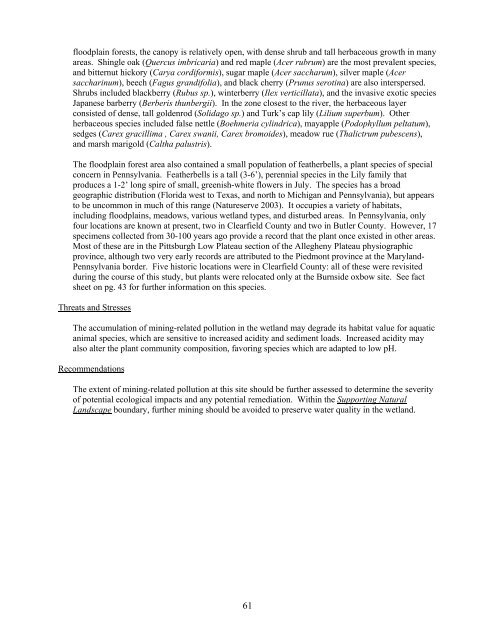introduction - Pennsylvania Natural Heritage Program
introduction - Pennsylvania Natural Heritage Program
introduction - Pennsylvania Natural Heritage Program
Create successful ePaper yourself
Turn your PDF publications into a flip-book with our unique Google optimized e-Paper software.
floodplain forests, the canopy is relatively open, with dense shrub and tall herbaceous growth in manyareas. Shingle oak (Quercus imbricaria) and red maple (Acer rubrum) are the most prevalent species,and bitternut hickory (Carya cordiformis), sugar maple (Acer saccharum), silver maple (Acersaccharinum), beech (Fagus grandifolia), and black cherry (Prunus serotina) are also interspersed.Shrubs included blackberry (Rubus sp.), winterberry (Ilex verticillata), and the invasive exotic speciesJapanese barberry (Berberis thunbergii). In the zone closest to the river, the herbaceous layerconsisted of dense, tall goldenrod (Solidago sp.) and Turk’s cap lily (Lilium superbum). Otherherbaceous species included false nettle (Boehmeria cylindrica), mayapple (Podophyllum peltatum),sedges (Carex gracillima , Carex swanii, Carex bromoides), meadow rue (Thalictrum pubescens),and marsh marigold (Caltha palustris).The floodplain forest area also contained a small population of featherbells, a plant species of specialconcern in <strong>Pennsylvania</strong>. Featherbells is a tall (3-6’), perennial species in the Lily family thatproduces a 1-2’ long spire of small, greenish-white flowers in July. The species has a broadgeographic distribution (Florida west to Texas, and north to Michigan and <strong>Pennsylvania</strong>), but appearsto be uncommon in much of this range (Natureserve 2003). It occupies a variety of habitats,including floodplains, meadows, various wetland types, and disturbed areas. In <strong>Pennsylvania</strong>, onlyfour locations are known at present, two in Clearfield County and two in Butler County. However, 17specimens collected from 30-100 years ago provide a record that the plant once existed in other areas.Most of these are in the Pittsburgh Low Plateau section of the Allegheny Plateau physiographicprovince, although two very early records are attributed to the Piedmont province at the Maryland-<strong>Pennsylvania</strong> border. Five historic locations were in Clearfield County: all of these were revisitedduring the course of this study, but plants were relocated only at the Burnside oxbow site. See factsheet on pg. 43 for further information on this species.Threats and StressesThe accumulation of mining-related pollution in the wetland may degrade its habitat value for aquaticanimal species, which are sensitive to increased acidity and sediment loads. Increased acidity mayalso alter the plant community composition, favoring species which are adapted to low pH.RecommendationsThe extent of mining-related pollution at this site should be further assessed to determine the severityof potential ecological impacts and any potential remediation. Within the Supporting <strong>Natural</strong>Landscape boundary, further mining should be avoided to preserve water quality in the wetland.61










